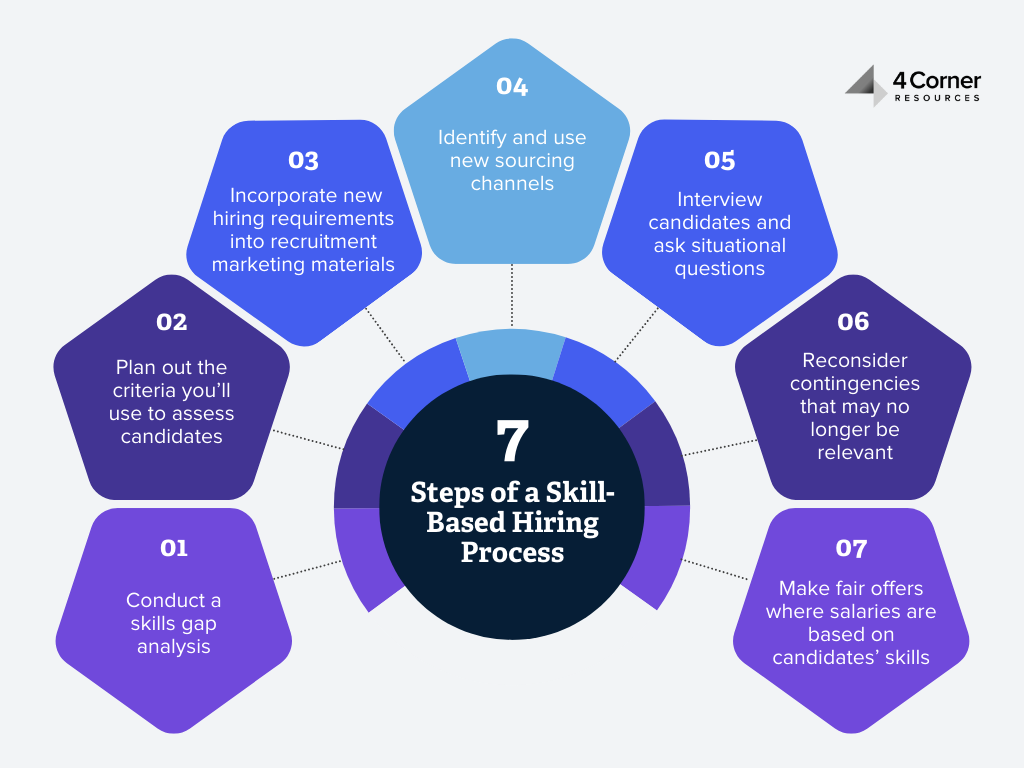How to Use Skill-Based Hiring to Build a Stronger Workforce

Seismic shifts are happening right now in the world of work. One thing that’s changing fast? The requirements to get a job. More employers are throwing out rigid education requirements in favor of hiring based on a candidate’s technical and personal capabilities. This is known as skills-based hiring.
We’ll define skills-based hiring, explain why more companies are adopting it, and share tips for building a stronger, more diverse workforce by hiring based on skills.
What Is Skill-Based Hiring?
In skills-based hiring, candidates are screened based on their hard and soft skills rather than their background or education. This method of hiring is different from degree-based hiring, where a candidate needs certain education credentials, like a Bachelor’s degree, to be screened into the next phase of the hiring process.
Skills-based hiring uses hands-on techniques like skills tests and job shadowing to assess candidates instead of relying primarily on an ATS that scans for specific keywords. It identifies candidates who possess the necessary talents and capabilities to accomplish a job rather than merely having a resume that looks a certain way.
Why Skill-Based Hiring Is on the Rise
Employers worldwide are struggling to fill open positions and cover skills gaps in their staffing charts. For example, the leisure and hospitality field has seen its hiring rate (the rate at which an industry is trying to fill open positions) fluctuate between 6% and 19% from 2020 to 2024. For context, the average hiring rate for all industries is a little under 4%.
At a time when good workers are scarce, strict requirements for education or background experience make it even harder for companies to hire, dramatically shrinking an already small candidate pool.
That’s why things are changing.
According to Payscale’s 2024 Compensation Best Practices report, one in three employers have eliminated degree requirements from their salaried job postings. This could be highly beneficial for the 62% of U.S. workers who do not have a college degree.
Walmart, which is America’s largest private employer, is one noteworthy example of the shift in hiring requirements. The commerce giant said in a 2023 blog post that it will now consider candidates with a relevant college degree or skills gained from prior experience for positions at its corporate headquarters.
As Walmart and other companies have found, hiring based on skills widens the candidate pool and opens opportunities to workers from more diverse backgrounds; it also helps promote employee longevity.

Searching for your next great hire?
Our recruiters are ready to deliver.
Benefits of Skill-Based Hiring
Overcome hiring challenges
The first and most pertinent benefit of skills-based hiring is that it can help companies address urgent staffing needs. Eliminating degree requirements encourages more candidates to apply, making it easier to fill open positions faster and at a lower cost.
More reliable than resumes
Hiring managers must remember that resumes are a candidate’s best presentation of themself. As a result, they can be embellished. Just ask any manager who’s onboarded a candidate who allegedly comes with “extensive experience” in a certain area, only to have to train them completely from scratch. Additionally, merely possessing a degree in a field of study doesn’t guarantee a person’s proficiency in it.
Skills-based hiring gives employers an accurate, verifiable picture of a candidate’s actual knowledge in any given area.
Inclusive of alternative candidates
Skills-based hiring opens up your hiring pool to candidates you wouldn’t have reached otherwise–coders who are self-taught, for example, or people who start their careers later after first raising a family.
It also helps identify transferable skills from candidates with non-traditional work experience. For example, someone who worked as a restaurant server likely has the customer service skills and attention to detail that would help them excel in a role like a personal assistant.
Reduce hiring bias
Scholars describe a sequence of events as the “success sequence”–a recipe for achieving economic success in America. The sequence is as follows: graduate from high school, get a full-time job or have a partner who does, and delay having kids until you’re married and at least 21 years old.
Skills-based hiring helps level the playing field for candidates who haven’t followed the narrowly defined success sequence, reducing bias toward things like degrees from a certain school or a specific type of work background.
Related: Beware of These Subconscious Hiring Biases
Improve hiring success
All hiring managers share one objective: to get someone capable and competent in the job. A new hire’s lack of technical skills increases training time, stalls productivity, and can contribute to turnover. Skills-based hiring increases the likelihood of making the right hire the first time around, helping control costs and improve time to productivity.
Challenges of Skill-Based Hiring
Added screening complexity
Screening resumes takes time. When certain criteria, like an educational requirement, are removed to filter out candidates, additional screening is required to assess candidates in other areas, like their technical skills.
Required infrastructure
It’s impossible to conduct skill-based hiring at scale without the proper infrastructure. This might include software like an applicant tracking system, subscription-based programs like skills assessments, and training for hiring managers in new assessment methods. This infrastructure comes with a cost, both upfront for implementation and on an ongoing basis.
Resistance to change
Some recruiters and hiring managers may find it difficult to adapt to new hiring methods and have trouble overcoming ingrained biases about what a “good” candidate looks like.
Lack of objective benchmarking
Judgments based on the traditional education system are somewhat simple. For example, we all know that someone with a master’s degree has more education than someone with a bachelor’s, and the person with a bachelor’s has more education than someone with an associate’s degree. When hiring primarily on skills, it’s not as easy to gauge experience level since most fields lack a universal standard for measuring proficiency.
Overemphasis on skills
Skill-based hiring can lead to overemphasis on skills and deprioritization of other important factors. Aspects like a candidate’s soft skills, work ethic, personality, and willingness to learn matter a lot in a candidate’s success.
Steps of a Skills-Based Hiring Process
Transitioning to a skills-based hiring strategy will impact most aspects of your hiring process. Here are the steps to include in your new approach and some considerations for the adjustments you may need to make.

1. Assess
Begin by assessing your skill needs. Identify what skills you’re currently lacking, where your competitors have an advantage, and what skills you’ll need for the future. Conducting a skills gap analysis always yields useful information to inform your hiring strategy. Still, it’s even more important in the current landscape, where skills are evolving faster than ever before.
Related: Skills Gap Analysis: What It Is & How to Conduct One
2. Plan
In a skills-based model, how you screen candidates will change significantly. Plan out the criteria you’ll use to prioritize candidates and the methods you’ll use to assess those criteria. In the next section, we’ll explore skills-based screening further.
Related: How to Create a Hiring Plan
3. Market
Make your new hiring criteria known to current employees, prospective applicants, and the general public. This can help you reach new talent pools and encourage candidates who may not have previously considered your organization. Incorporate your revamped hiring requirements into job descriptions and recruitment marketing materials.
4. Source
The sourcing channels used when hiring based on skills will likely be different, or at least broader, than the channels you’ve traditionally used to find candidates. Suppose you’re looking for IT skills, for example. In that case, you might shift your focus to sourcing from coding boot camps or filtering candidates by technical credentials rather than years of experience on LinkedIn.
5. Interview
Again, this is another area where your focus will need to shift. Emphasize situational questions that ask a candidate to describe how they would tackle a particular challenge or apply their skills in a real-world setting and behavioral questions that prompt a candidate to explain how they’ve successfully leveraged their skills in the past. Ensure objectivity by asking all candidates the same questions.
Related: The Best & Worst Interview Questions to Ask Candidates
6. Reconsider contingencies
Some of your employment contingencies, like background checks that verify educational credentials, may no longer be relevant. On the other hand, reference checks may take higher priority as you aim to identify candidates’ past achievements.
7. Hire
Make fair offers where salaries are based on candidates’ skills and the value they will bring versus years of experience or education level.
How to Hire Based on Skills
Skills assessments
The easiest way to practice skills-based hiring is to use skills assessments. These are unbiased tests that provide a verifiable way to evaluate a candidate’s ability to perform the duties listed in the job description. Skills assessments can focus on hard skills, like programming languages, or soft skills, like decision-making.
Related: How to Use Pre-Employment Assessments to Make Better Hires
Skill-based interview
A skill-based interview asks questions designed to determine whether a candidate’s abilities align with the organization’s needs. Here are a few examples:
- What is data analysis, and what tools do you use to conduct it?
- Tell me about a time when you had to use conflict resolution at work.
- What’s the most complex manufacturing process you’ve worked on?
As you can see, these questions zero in on particular skill sets and a candidate’s proficiency with them, as opposed to much less specific questions like “Tell me about your background.”
Job auditions
A job audition is a step of the interview process that involves a simulation or actual trial of the role a candidate has applied for. Candidates might work alongside an existing employee in the role or be asked to complete a test project. Job auditions give hiring managers a tangible example of how to judge a candidate’s aptitude.
Upskill and Reskill on the Job
The emphasis on skills should continue even after a hire is made. As the U.S. Chamber of Commerce advises, “Businesses can increase their hiring pools by… [providing] opportunities for new and existing staff to be upskilled and reskilled on the job.”
It’s one of the steps IBM took in the initiative we mentioned earlier to prioritize skills. According to the company’s CHRO Nickle LaMoreaux, “the half-life of skills is shortening,” meaning that all workers require constant training to remain competent and help the company stay competitive.
Related: Strategies for Upskilling and Reskilling Your Workforce
